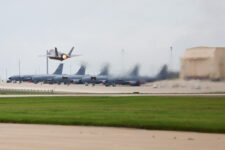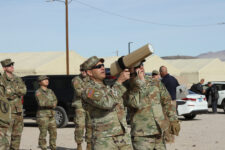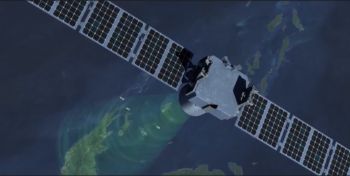
F-35As over Nellis AFB, Nevada
WASHINGTON: The Air Force just wrapped up a first-of-its-kind test to hone how stealthy aircraft can work in tandem in highly contested airspace — with the F-35A providing critical anti-air defense cover for older aircraft, including the B-2 bomber and the highly classified RQ-170 surveillance drone.
The two-day exercise at Nellis AFB in Nevada also included Air Force F-22, F-15E fighters and the Navy’s E/A-18G Growler electronic warfare plane, with the aim of pairing fourth- and fifth-generation aircraft in conducting electronic attacks (EA) missions.
“Most people don’t think of F-35s as electronic warfare aircraft—but they are, and they are incredibly capable,” Mark Gunzinger, director for future concepts and technology assessments at the Mitchell Institute for Aerospace Studies, told Breaking D in an email today. (Breaking D readers have known that for a much longer time than most.)
“F-35s have EW suites that can detect emissions from radars and other threats, classify and geolocate them, and then distribute threat data to other aircraft. They can also perform active EW tasks such as standoff jamming of airborne and surface threats. Their active electronically scanned array (AESA) radars can also conduct electronic attacks,” he explained.
The $1.4 million Large Force Test Event was “designed to find solutions to Air Force prioritized Tactics Improvement Proposals for Suppression of Enemy Air Defense, low-observable ingress, and 4th-5th generation electronic attack interoperability,” the 53rd Test and Evaluation Group says in a press release today. “As a result of the LFTE, the Air Force to explore unique integration of tactics, techniques, and procedures that have never been tested together,” the release added.
“This exercise is primarily focused on demonstrating LO [low observable] platform effectiveness against advanced threats,” Maj Theodore Ellis, chief of 53rd Wing Weapons, says in the release. “We do this by utilizing emerging technology and tactics to minimize weaknesses and capitalize on joint capabilities.”
“An LFTE is so important because it’s not singularly focused on one platform, but rather on the collaboration and interconnectivity,” 1st Lt. Savanah Bray, an Air Force spokesperson, says in an email to Breaking D. “So, it’s not focused on the F-35’s EW capabilities against SEAD, but rather how the platforms are able to synergize in a singular effort.”
That said, the test event was also an opportunity for Air Force leaders to explore the F-35’s abilities to play a leading role in directing multi-domain operations — a role that just-retired former Chief of Staff David Goldfein likened to the “quarterback” of a football team calling out plays.
“The Large Force Test Event highlights the F-35’s ability to integrate both legacy aircraft, as well as other high-end assets including other F-35s, to achieve mission success and survivability using a combination of stealth, electronic attack, information sharing, and other measures,” Brett Ashworth, spokesperson for prime contractor Lockheed Martin, says in an email to Breaking D today.
That capability was also on display during the 2020 version of the annual Orange Flag exercise at Edwards AFB in California. The Air Force F-35A collected targeting data and bounced it to a U-2 spy plane service as an airborne communications node, as well as to a simulated Army Integrated Air and Missile Defense Battle Command System (IBCS). IBCS, as Breaking D readers know, is the Army’s high-priority command and control system for its missile defense weapons — a system that Strategic Command chief Adm. Charles Richards says is critical to enabling all domain operations.
“The ability to share their operational picture, act as battle managers, and perform as electronic warfare assets make F-35s potent force multipliers,” Gunzinger said.
Union workers strike at Pratt & Whitney plant where F-35 engine is made
Pratt & Whitney said in a statement that it has “contingency plans in place to maintain operations and meet our customer commitments” and has no “immediate” plans to resume negotiations with the union.
The suppression of enemy air defenses mission, known as SEAD, has become a more pressing need in recent years, according to air warfare experts.
First, peer competitors such as Russia and China have spent much time and treasure improving their anti-access/area denial capabilities, also helping to spur proliferation of sophisticated air defenses to countries such as Iran. Advances in intelligence, surveillance and reconnaissance, including space-based, also have raised the likelihood that stealth technologies will be rendered moot.
“Perhaps most importantly, many believe that stealth is perishable anyway — implying the need, at least in the future, for EA/SEAD cooperation,” Teal Group’s Richard Aboulafia told Breaking D in an email today.
But also, the new emphasis on EA and SEAD has been borne of choices made by the Air Force itself, largely due to budgetary pressures.
“Originally, USAF wanted to be an all fifth-gen force, with no need of Electronic Attack/SEAD. Then, it was a division of labor—fifth-gen for kicking down the door; legacy assets for day two and beyond,” Aboulafia explained. “But it’s increasingly clear that the Navy will have very little fifth-gen, and that they’ll need to cooperate. And given the F-15 procurement re-start, it’s clear that the Air Force will need to work with fourth-gen platforms in many roles for many decades to come.”
LFTEs “are Air Combat Command’s principal event for operational test warfighters to evaluate the suitability and effectiveness of emerging capabilities within an integrated and operationally realistic scenario,” the Air Force press release explained. “Unlike joint or multiple-platform exercises that focus on the training and readiness for units with fielded capabilities, such as Red Flag, LFTEs focus on yet to be fielded hardware, software, and tactics. Results from LFTEs inform a wide range of efforts to include capability development and the latest tactics, with a focus on integration.”
“Through events like these, we continue to improve our joint 4th and 5th generation tactics, which enhances our abilities in an advanced threat environment,” said Ellis.


























